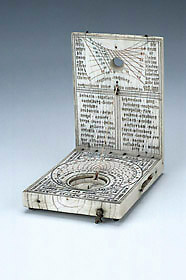
 |
| Catalogue |
 |
 Diptych Dial The inner part of the upper leaf has a vertical pin gnomon dial (pin missing) for Italian hours (numbered in red from 13 to 24) and length of the day and the night numbered in green from 8 to 16, inscribed 'tagleng' and 'nachtleng'. The dial is inscribed on the left side 'dise spicz zeiget die gancz uhr sindt die roten linien' ('this tip shows large hours [which] are the red lines'). On the right is the inscription 'die krum en linien mit den bloeben ziferes bedeiten der tags und der nach[t] leng' ('the bent lines with the blue numbers represent the length of the day and of the night'), and at the bottom 'nachvolgente lender diesen campast zu brauchen' ('the following [are] countries [where] this compass [can] be brought') and a list of places. The inner part of the lower leaf has a compass (glass and needle missing) marked with the abbreviated names of the cardinal points, and a vertical string dial adjustable for latitudes 50?, 51? and 52?. The dial marks Italian hours numbered from 8 to 23 in red, Babylonian hours numbered from 1 to 16 in red, common hours numbered from IIII to XII to VIII with dots for the half hours, and length of the day numbered from 8 to 16 in black. At the centre is the inscription 'die bloeben zal ist der tagleng bedeiten die zirchel' ('the blue number is the day length represent[ed by] the circles') 'krikisch teutsch un welsche uhr' [i.e. Babylonian, common and Italian hours], 'MORS VENIT HORA FVGIT METVAS MORTEM VENIENTEM QUAELIBET EST INDEX FUNERIS HORA TVI ANNO 1580' ('death comes, the hour flies, be mindful of approaching death. Each hour is an indication of the hour of your funeral. Year 1580'). The outer part of the lower leaf has a wind rose with 8 winds and a 12-leaf flower in the centre, and indicates the directions of 25 places. On the border and in the bottom spandrel spaces is the inscription 'wen ich campast recht sol weissen so tun mich nicht naher zu eisen auf pollus hog 51 gradt bin ich gemachteben geradt 50 und 52 kan ich leiden weiter sol ich meiden' ('if I, compass, am to point properly then do not place me near to iron. I am made for pole height 51 degrees and degrees 50 and 52 may I just endure, more must I avoid'). In the top spandrel spaces is punched the maker's mark and the quality mark 'n' (for Nuremberg). There are four bun feet (one missing) and on the right edge is a compartment for the wind vane (missing). See P. Gouk, The Ivory Sundials of Nuremberg 1500-1700 (Cambridge, 1988). Ilaria Meliconi |



